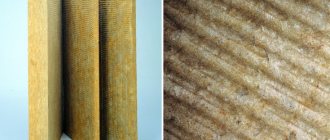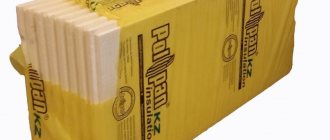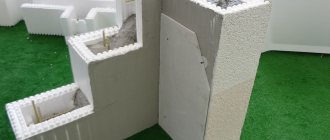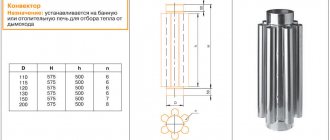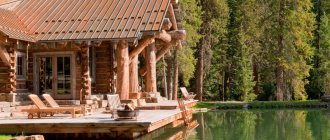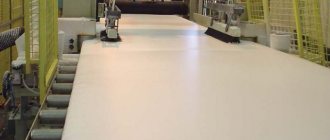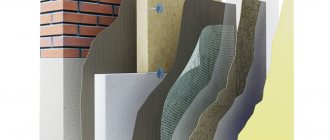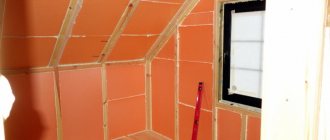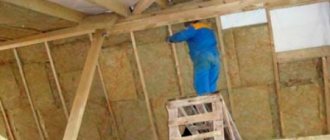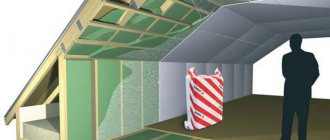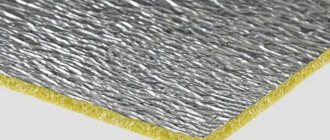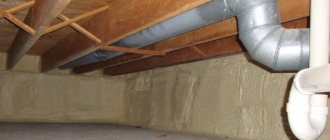Material Specifications
The technical parameters of foam plastic allow it to be widely used in many industries. The most important of them include:
good thermal insulation characteristics. As you know, the lower the thermal conductivity, the better the material retains heat. The thermal conductivity of foam plastic is approximately 1.2 times lower than that of mineral wool and 4 times lower than that of wood. According to this criterion, dry foam concrete and brick are much inferior to polystyrene foam; availability of material. It is advisable to use polystyrene foam as insulation due to its affordability. The cost depends on the thickness of the slabs. Homeowners choose extruded polystyrene foam; reviews confirm that it has better ability to retain heat, but is also somewhat more expensive; manufacturability
It is also important that foam plastic is light in weight, easy to cut, and very convenient to work with; even one person can do it. In addition, such material does not weigh down the structure of the house, which is a significant advantage.
Fire resistance
Being a combustible material, polystyrene foam has good fire resistance, since the spontaneous combustion temperature is +4910 C. This indicator is 1.8 times higher than that of wood, for which +2600 C is enough. In the absence of fire within 4 seconds, the combustion dies out. During combustion, the material releases about 1000 MJ/m3 of energy, while wood - 7000-8000 MJ/m3 - which means that when burning polystyrene foam, the temperature increase will be much lower.
Manufacturers offer self-extinguishing polystyrene foam made with the addition of fire retardants. However, experiments show that the self-extinguishing effect is lost over time, and in the design the material, which was initially classified as belonging to the G2 flammability group, after some time already corresponds only to the G4 class (research carried out at the Research Institute of Industrial Safety and Emergency Situations of the Ministry of Emergency Situations of Belarus).
At the same time, it should be recognized that the products released during the combustion of different brands of polystyrene foam are still poorly studied.
Application in construction
The low cost of expanded polystyrene reduces material costs, and ease of installation reduces labor costs. Reduced heating costs allow you to quickly return the money spent on thermal insulation.
Walls
Polystyrene foam can be used for both internal and external thermal insulation of walls. The most common method is when insulating polystyrene foam boards are glued to the outer surface of the wall with a binder solution and covered with a layer of plaster. Reinforced fabric, which is used as a gasket, serves as a compensator for stresses arising from temperature fluctuations.
Another thermal insulation system is permanent formwork. The parts are laid dry and the voids are filled with concrete mortar.
It is also possible to use polystyrene foam together with hollow brickwork, when the insulating layer is placed between the load-bearing wall and the facing masonry.
For internal insulation, walls are covered with polystyrene boards in combination with plasterboard, chipboard, decorative plaster or ceramic tiles. Simple and almost dry installation allows for quick occupancy of the premises.
Floors
Expanded polystyrene boards as floor insulation additionally significantly reduce the transmission of impact noise from footsteps, the operation of office equipment, and moving furniture. Plates up to 50mm thick are laid on an insulating layer, and chipboard is laid on top.
Expanded polystyrene floor insulation is often combined with heated floors to prevent downward heat loss. In this case, slabs with formed recesses are used, which simplify the installation of heating system elements.
Roofs
Two main types of roofs can be constructed using polyurethane:
- a non-ventilated roof, when the supporting structure is covered with slabs whose thickness reaches 70 mm, and a waterproof bitumen roofing covering is laid on the surface of such a layer;
- ventilated roof, when polystyrene foam boards are mounted on the back side of the roof, leaving a ventilated cavity that prevents the formation of condensation.
Expanded polystyrene can be used for both flat and pitched roofs.
Foundation
The condition of the entire building largely depends on the condition of the foundation. In modern construction, expanded polystyrene is often used as permanent formwork, reducing the consumption of reinforcement and concrete.
When constructing buildings without basements, the insulation slabs laid on the site are poured with concrete and then construction is carried out according to the planned scheme.
To protect the foundation from freezing, a trench is dug around the perimeter, the depth of which is determined by the depth of soil freezing, polystyrene foam slabs are laid in it and covered with soil.
Pipelines
Heat loss through utilities can reach 30%. Expanded polystyrene, the use of which is becoming increasingly widespread for pipeline insulation, allows you to protect pipelines from freezing, while reducing the installation depth. The ability to shape the material into virtually any shape increases functionality and the ability to adapt to design requirements.
Refrigeration equipment
Expanded polystyrene meets all requirements for refrigeration equipment. It can be used for thermal insulation of walls, ceilings and even floors that are subject to large static loads from stored goods and dynamic loads from the movement of forklifts.
The consumer should know about the qualities of common materials; this makes it possible to make an informed and optimal decision when choosing building materials.
Strength
With a low density (0.015-0.05 g/cm3), polystyrene foam has high bending and compressive strength. Due to this, it is used in the construction of roads and runways.
Durability
Long service life is ensured by proper operation. According to research, no irreversible changes occur in polystyrene foam within the range from -1800C to +800C. With prolonged exposure to higher temperatures, the material is destroyed, but within a few minutes polystyrene foam can withstand temperatures of +950C. This allows the material to be used in cases where short contact with hot bitumen is required. Recommended operating temperature - from -200 to +85°
Facade insulation
The service life of expanded polystyrene is also extended by the fact that the material is not susceptible to rotting. Manufacturers indicate the service life range of the material from 15 to 60 years.
Ease of use
The low weight of the material makes it easier to transport and install, and practically does not create additional loads on supporting structures and foundations, which opens up wide possibilities for use in the reconstruction of old buildings.
Conventional tools can be used for cutting. The use of special protective equipment is not required during operation. Work can be carried out at any time of the year.
What determines the service life
The expected service life of the foam is possible under ideal operating conditions. The insulation must be additionally protected from mechanical and aggressive influences. For this purpose, chipboard, OSB, plywood, gypsum and cement putty, polyethylene reinforcing mesh, brick, concrete, and board are used. At the same time, it has long been proven by time that foam plastic does not collapse upon contact with these protective materials and does not shrink.
Such insulation does not burn with an open flame, but at the same time it emits harmful volatile substances. Reliable protection of polystyrene foam from high temperatures is the most important condition for its long-term operation.
The most effective method of thermal insulation is the use of polystyrene foam as an insulating core when concreting foundations, laying brick walls, and foam blocks. In this case, reliable insulation protection ensures maximum service life.
Expanded polystyrene was invented in the 50s of the last century. To say that its service life has been proven by time would not be entirely correct. In the NIISF laboratory, scientists, as a result of lengthy tests, found that polystyrene foam in multilayer structures successfully withstands cyclical changes in outside air temperature, even at high humidity. It has been practically proven that such insulation can last at least 100 “conditional” years.
An important condition for the long service life of polystyrene foam is its quality. Therefore, it is necessary to purchase such building material from trusted suppliers who are official representatives of well-known manufacturers.
Types of foam and performance data
For work, foam-based insulation is used, not all of them are slab. Their service life and conditions are different. The following types of heat insulators are known:
Table of characteristics of various brands of polystyrene foam.
- PSB-S-15 is a low-density material that can be used for insulating roofs between rafters, where high mechanical strength is not required.
- PSB-S-25 is a universal foam plastic that is most often used for work. It is resistant to moisture, it is used for insulation of facades, floors, interior walls, attics, balconies, i.e. The scope of application is wide. The service life of this material is long, and the operating conditions are not so demanding.
- PSB-S-35 is a durable material that is used for waterproofing and insulation of foundations when it is necessary to prevent soil heaving. It is used under the most unfavorable conditions, the service life is significant, as is the stability.
- PSB-S-50 - high mechanical strength, the resistance of the insulation to various types of influences is the best. Aging rate is low.
Polystyrene foam is available in the following types:
Comparison table of polystyrene foam and polystyrene foam.
- Polystyrene, i.e. unpressed and pressed material, which has high performance characteristics. Available in the form of slabs, convenient for work. Polyurethane material in the form of foam rubber allows you to perform thermal protection work, which is necessary for internal walls, for cladding structures where rigidity does not matter.
- Polyethylene is an elastic material that is a film with air bubbles. It is used only for packaging; it is almost never used in construction, since its service life is short.
- Polyvinyl chloride products are similar to extrusion materials, the elasticity is greater, but the service life and conditions of use are sufficient for wall insulation.
- Polyurethane foam is the highest quality and most durable among foams. It is applied only in liquid form by spraying, hardens quickly, after which it forms a very strong film that can withstand almost any impact. The quality of this material is high and its service life is long.
Types of foam plastic and their performance characteristics
For construction and thermal insulation work, mainly foam insulation materials, their slab and non-slab varieties, are used. The most common types of thermal insulators for building facades are:
PSB-S-25 is the most versatile type of foam, resistant to moisture, suitable for both external and internal work. The service life of this material is tens of years (from 40 to 80), and it is unpretentious in maintenance.
PSB-S-35 is a very durable and dense material used for progressive waterproofing. Ideal for areas with high humidity levels due to constant rainfall. Its minimum service life is 120 years, and its outstanding qualities allow it to be used to create eco-friendly facades.
PSB-S-50 is the most durable and durable type of thermal insulation. The service life of foam plastic as insulation is about 200 years, and the aging level is extremely low. The material is resistant to fungus, mold, and corrosion.
The most commonly used additional materials for polystyrene foam are:
polyurethane foam rubber - suitable for cladding internal walls of the facade, as well as cladding a number of structures where rigidity is not important; is an excellent alternative to heat insulators such as eco-facades;
polystyrene boards are the most convenient material to work with. The slabs can be unpressed or pressed;
polyethylene is a flexible and elastic material that looks like an air film. Used only in the packaging process, it is the most fragile and short-lived;
polyurethane foam is a leader among building materials for thermal insulation. It is applied from special reservoirs, sprayed onto the wall: when it hardens, it forms a dense film that can withstand any negative environmental influences.
Wear resistance
It is necessary to pay attention to how much the material resists wear. Typically, manufacturers independently conduct the necessary research, which includes tests for resistance to certain types of loads.
This wear can be associated with various parameters. The most common causes are temperature, moisture and aggressive substances. The results obtained make it possible to conclude that during the entire service life and even longer, signs of wear do not appear on the foam boards. These periods are 20-50 years depending on the type and type of material. Such conditions are quite sufficient to perform high-quality cladding of the external and internal walls of the house, roof, attic and foundation, where polystyrene foam can be used as waterproofing.
Expanded polystyrene, also called polystyrene foam, is a white insulating material. 98% of the material is air, trapped in thin-walled polystyrene foam cells. The biological safety of the product makes it possible to produce food packaging from polystyrene foam. The technical characteristics of expanded polystyrene, lightness and ease of processing have become the key to success and widespread use as a thermal insulation material.
Technical characteristics of high-quality polystyrene foam
Before ordering a large batch of such insulation, you need to familiarize yourself with its technical characteristics, which must be provided by the supplier. They are as follows:
- Density for PSB-S-25 from 15-25 kg/m³, PSB-S-35 from 25 to 35 kg/m³, PSB-S-50 from 35 to 50 kg/cm³;
- Compression resistance from 0.08 to 0.23 MPa depending on thickness;
- Bending strength from 0.06 to 0.3 MPa depending on thickness;
- Water absorption at full immersion for 24 hours from 3% to 1%;
- Self-extinguishing time outside an open flame is 1-2 seconds;
- The material must have flammability class 3;
- Thermal conductivity coefficient 0.39-0.35 W/μ;
- Vapor permeability coefficient 0.05 mg;
- The recommended operating temperature at which the insulation does not emit harmful substances is from +60 to +90 ⁰С.
Such characteristics will ensure a long service life of the foam with reliable protection from external mechanical and chemical influences.
Features of application
EPP is widely used in construction and everyday life. Thanks to its lightness, strength and excellent thermal insulation, it has become possible to make containers from it for storing and transporting food and other substances, disposable tableware, as well as business cards and even toys that have become commonplace. However, its main purpose is still construction thermal insulation for conditions of high humidity and mechanical load. In this application it has no equal.
Despite the ease of installation, the use of EPP for insulation of various construction sites has its own characteristics.
Application for roof insulation
Roof insulation with extruded polystyrene foam
- For inversion roofing, insulation boards are laid over the waterproofing so that its layer receives mechanical and temperature protection. This will allow you to save on additional steam protection and carry out work in any weather.
- For flat roofs, extruded polystyrene foam can be layered over old and deteriorating insulation. This will not only not interfere, but will provide secondary protection and strengthen your roof for a long time.
- For a pitched roof, insulation boards are laid on top of the rafters, directly under the roofing.
Application for thermal insulation of walls
Insulation of loggia walls with extruded polystyrene foam
The walls of frame, wooden, block and other houses may also require thermal insulation:
- For external walls, polystyrene foam is secured using dowels for subsequent application of a layer of plaster and final finishing.
- For interior walls, insulation boards are placed between the slats, to which the drywall will then be attached.
Application for floor insulation
Floor insulation with extruded polystyrene foam
Floor insulation using EPP prevents possible moisture condensation on the walls inside the house and basement:
- To insulate wooden floors, insulation rafts are laid between their layers - rough and finishing, secured between the joists.
- Floors on the first floor are often insulated with a double overlay, where the polystyrene foam slabs of the top layer overlap the joints of the slabs of the lower layer.
- When insulating a heated floor, the slabs are placed on the floors between floors.
Application for foundation
Foundation insulation with extruded polystyrene foam
Extruded polystyrene foam is indispensable in foundation thermal insulation due to its high technical characteristics:
- For the outer insulating layer, EPP boards are used without special protection.
- When groundwater pressure occurs, holes are made in the slabs to allow moisture to drain freely.
Extruded polystyrene foam is an excellent insulating material for any work on a construction site, both industrial and civil construction.
The important thing is that it can be used at any stage of construction, for any operation of insulated premises. For your convenience, modern EPP is produced in various configurations: grooves and tenons, selected quarter, rectangle, etc.
To ensure that its use does not cause problems, you need to adhere to some rules for use. In particular, the correct choice of glue plays an important role, since some substances contribute to the softening and shrinkage of the boards.
You can even store this material outdoors, only in its original packaging. He is not afraid of heat or repeated freezing. Tests show that its service life, even in harsh conditions, reaches 50 years.
Types of expanded polystyrene
Expanded polystyrene is a modern material, thanks to which excellent thermal insulation of the building is achieved. It is used both for insulating the walls of houses and for thermal insulation of the foundation (regardless of the groundwater level).
But the scope of use of expanded polystyrene is not limited to this. Roofing, flooring, water pipes, transport routes, window and door openings - all these elements can be insulated with this material. Granulated polystyrene foam can act as a filler for packaging or a decorative element in the interior decoration of rooms.
The following types of insulation exist:
-pressless;
- extrusion;
-autoclave;
-press.
The most popular type of expanded polystyrene is non-press material. Moisture is removed from the granules through a drying process. After which the material is foamed at a temperature of 80-85ºС, dried and reheated. The resulting mixture is placed in a special form. As the material cools, it compacts on its own. Pressless polystyrene foam is the most fragile, since a minimum amount of isopentane is used for its production (naturally, it is also the cheapest product).
In the production of extruded polystyrene foam, special equipment is used - an extruder. The material is obtained after processing the final polymer product. In most cases, extruded polystyrene foam acts as a raw material for the manufacture of packaging containers.
The main difference between autoclaved polystyrene foam and extruded material is the use of an autoclave. This equipment is used for foaming and exposure to high temperatures.
The most expensive product is the press material. The technology for manufacturing granulated polystyrene foam of this type occurs using gas. This insulation has maximum strength.
PPS slabs
A very attractive feature of expanded polystyrene is the ratio of product quality and low price.
The most popular type of PPS is slabs. This form is most convenient for installation. Expanded polystyrene boards are produced by both domestic and foreign manufacturers. Slabs are available for sale in sizes 60 x 120 centimeters and 50 x 100 centimeters. Expanded polystyrene boards with fire retardants are marked with the letter “C”. To insulate residential premises, the density should be 35-40 units, for example, this marking is PSB-S-35. A lower density does not have good insulating properties. The plates are equipped with recesses, which ensure a tight connection with each other.
The positive aspects include: light weight of the slab, good strength, low cost, ease of installation, resistance to moisture.
Negative points: insufficient vapor permeability, inability to use for insulation of high-rise buildings, low fire resistance, incompatibility with organic solvents.
Properties and technical characteristics of polystyrene foam
Safety
Expanded polystyrene can be reused. From the production process to disposal, it does not harm the environment and health.
Numerous studies have been carried out, during which styrene was not detected in air samples taken from building structures using expanded polystyrene.
Thermal conductivity
Such low thermal conductivity values:
- guarantee good energy saving indicators;
- reduce space heating costs;
- increase the service life of pipelines, protecting against freezing.
The heat-saving properties of the material, which are preserved at high humidity and low temperatures, are used in the equipment of refrigeration units and warehouses.
Polystyrene foam balloons
The thermal conductivity indicators of different types of polystyrene foam depend on the density - the more compressed the material is, and, accordingly, the higher the styrene content, the worse the material retains heat. Extruded polystyrene foam has a lower thermal conductivity (0.028 W/mK), since the styrene granules are soldered into a single sheet, and there are no gaps between them.
| MATERIAL | DENSITY KG/M3 | THERMAL CONDUCTIVITY (W/mK) |
| Mineral wool, slabs | ||
| Expanded polystyrene (foam) | ||
| PSB-S15 | ||
| PSB-S25 | ||
| PSB-S35 | ||
| PSB-S 50 | ||
| Extruded polystyrene foam | ||
| Mark 35 | ||
| Mark 45 | ||
| Concretes and mortars | ||
| Concrete | ||
| Reinforced concrete | ||
| Expanded clay concrete | ||
| Foam concrete | ||
| Other materials | ||
| Gas silicate | ||
| Drywall |
The comparison table of building materials clearly shows that the thermal conductivity of polystyrene foam is not comparable to other materials.
Soundproof and windproof
When insulating with polystyrene foam boards, additional wind protection is not needed, and at the same time, the sound insulation of structures is improved.
As the thickness of the layer increases, the noise-absorbing and sound-proofing qualities increase.
Waterproof
The structure of the material is not hygroscopic, it does not absorb moisture and water, does not dissolve and is not subject to deformation and swelling. The amount of water that can penetrate into the cavities between the granules does not exceed 3% of the weight of the slab, while all the properties of polystyrene foam remain unchanged.
Water and steam escape easily from polystyrene foam; design rules must be followed to avoid condensation.
Styrofoam
Moisture resistance allows the material to be used for insulating foundations, where direct contact of the insulation with the ground is inevitable.
Products.
Polyspen slabs are available in different densities. The specifics of their application depend on this parameter. In addition, insulation may differ in thermal characteristics, flammability and compressive strength.
The slabs, whose density is 45 kg/m3, can withstand heavy loads - up to 50 tons per square meter. Their main purpose is to construct runways, including railways and highways. Also used for thermal insulation of foundations, heavily loaded floors, and used roofs.
The thickness of the insulation varies between 20-80 mm, the standard length is 120 cm. The latter indicator can be changed upon individual request (order).
Consumer Opinions
For those who want to understand what polystyrene foam is like in practice, consumer reviews will be useful. Below are some of them.
Artyom, private developer: “I have been working in the field of facade insulation for many years. I want to say that polystyrene foam is one of the best materials. Mineral wool is also good, but it is more expensive. And polystyrene foam is quite cheap, easy to process, and can be used to insulate a room very quickly.
Evgeniy: “I had experience using expanded polystyrene during construction work. Last summer, I didn’t have time to complete the second floor of the house; I had to quickly insulate what was ready before the cold weather set in. I purchased slabs 50 mm thick. I laid polystyrene foam, covered everything with siding on the outside, and sealed the gaps with polyurethane foam.
I haven’t had any problems with heat in the house all winter, which I’m very pleased with. I completed all the work alone and quickly; I used an ordinary cutter to cut off the excess. The downside of the material, in my opinion, is its fragility, but foam plastic has more advantages.”
Galina: “In principle, I liked polystyrene foam, the reviews about it are mostly positive. But, in my opinion, this material is more suitable for apartments. It is not advisable to use it in private homes where there may be mice.
When insulating the garage, I encountered the problem of damage by rodents; mice soon made holes in the material, so I don’t plan to use it for my dacha house. Despite this, it became very warm in the garage, but I really doubt the durability.”
Nikolai: “About 4 years ago I bought a corner apartment in an old brick house, and soon the problem of insulation became very acute. It was cold in the bedroom in winter. A friend recommended insulating the walls with foam because it is quick, inexpensive and easy.
Each homeowner has the right to decide for themselves which insulation to choose for their home.
You should always take into account the characteristics of a particular room, the importance of individual characteristics, and financial costs. However, polystyrene foam can be an excellent option in many cases.
Advantages of polystyrene foam
One of the thinnest insulation materials
Among all insulation materials, ordinary polystyrene foam, also known as expanded polystyrene, has almost the lowest thermal conductivity coefficient. What does it mean? This means that its thickness as insulation will be the smallest compared to other materials. Here is a list of these materials in increasing order of their ability to conduct heat:
- Penoizol (50 mm).
- Foam insulation (75 mm).
- Mineral wool (125 mm).
- Wood (340 mm).
- Brick wall (900 mm).
- Concrete (2132 mm).
- the thickness of the materials at which their equality as heat insulators is achieved is indicated in brackets;
- penoizol is a liquid material that consists of several components. When they are mixed, it swells and hardens. At the same time, it acquires a porous light structure similar to hardened polyurethane foam. Its main disadvantage is toxicity. Therefore, it can only be used for insulation of non-residential premises. Usually, it is poured into a specially prepared cavity inside the wall.
The lightest insulation
Finding out the weight of polystyrene foam boards is very simple. All manufacturers indicate the density of the material on the packaging:
- 15 kg/m 3;
- 25 kg/m3;
- 35 kg/m3.
And the density of one cube is its weight. That is, one cube weighs 15, 25 and 35 kg, respectively. By the way, this is how you can check the quality of the material you buy. If the package says 25 kg/m3, and the tested package of sheets weighs less, don’t hesitate. You were a little misled.
Sometimes the manufacturer bypasses this point. For example, a package with a declared density of 25 kg/m 3 will contain sheets with a actually lower density. But this packaging will have its own beautiful name. And a pack of sheets with a real declared density will be called differently: “Warm House”, “Standard” or “What else”. But, in any case, the lighter the pack, the lower the density of the insulation. Remember this.
For work, you can use foam of any density. The main thing is to understand that the lower it is, the more fragile and fragile the sheet will be in your hands. But the use of such sheets, for example, on the first floor of a building is not recommended - the facade can easily be damaged by an impact. Therefore, the denser the sheet, the better.
One of the most inexpensive insulation materials
This is truly the most inexpensive industrial insulation material. At the same time, two types are used in construction practice:
- sheet foam;
- foam chips or balls.
Today, the selling price for both of these species is approximately equal. Most likely, this is due to an increase in demand for balls. Most often they are used for roof insulation. The cement-sand mixture is mixed with balls and poured onto the ceiling. It turns out warm, durable and inexpensive.
Polystyrene foam is a very multifunctional insulation material.
Here are its main areas of application:
- wall insulation;
- roof insulation;
- floor insulation;
- insulation of the basement of the house.
Insulating walls with foam sheets has become a classic today. The result is very warm, relatively inexpensive, quite durable and reliable. In terms of service life, polystyrene foam covered with a layer of plaster can last for a very long time. Manufacturers guarantee the service life of facades made of polystyrene foam boards without major repairs for 30 years. They say that in Germany, houses insulated with foam plastic are insured for longer periods. Up to 100 years.
When insulating a roof, polystyrene foam chips or balls in a cement-sand mixture are most often used.
Extruded polystyrene foam is used for the floor and base. It differs from conventional foam in its manufacturing technology, being more dense and durable. But its price is much higher.
A little more positive about polystyrene foam
Polystyrene foam is the most convenient and pliable building material to work with.
It can be cut with a knife or hacksaw. You can easily make any hole or recess in it. This property is very much used by builders when designing shaped elements of a building facade. Cornices, ledges, window frames and other architectural elements are very easy to make from such a convenient material. Due to its lightness, the foam element can be glued to the facade anywhere. Well, after the glue has dried, it can easily be further processed, for example, with a drywall plane.
These were the strengths of foam insulation. But, like any other material, it also has its weaknesses. What are the disadvantages of polystyrene foam and why can’t it be used to insulate a basement or ventilated facade?
Production Features
Extruded polystyrene foam has a number of important distinctive properties, which is explained by the peculiarities of its production technology. It is fundamentally different from the method of manufacturing conventional expanded polystyrene foam.
To obtain this special material, polystyrene granules are mixed with a foaming agent (carbon dioxide + a mixture of light freons) at very high temperatures and pressures. Then the resulting mass is squeezed out of the extruder under pressure. After cooling, this compressed foam mixture forms a slab with a closed-cellular structure, called “extruded” after the method of production.
Production of extruded polystyrene foam
Resistance to biological and chemical factors
Polystyrene is able to retain its properties even in contact with:
- saline solutions, for example sea water;
- soap solutions and detergents;
- bleaching agents (chlorine water, hydrogen peroxide, hypochloride);
- acids (except for concentrated acetic and nitric);
- ammonia;
- lime;
- plaster;
- adhesive solutions;
- water-soluble paints;
- cement.
Expanded polystyrene is not suitable for animal food and does not promote the development of algae and microorganisms. During installation, termites and rodents should be prevented from accessing the foam, as they can cause damage. Partially decomposes under the influence of bitumen solutions and organic solvents. Stability is determined by the quantitative ratio of closed and open pores, which depends on the type and brand of material.
Advantages and disadvantages
Polystyrene sheets have few disadvantages: low bending strength; destruction upon contact with certain types of paints and aggressive compounds; insufficiently high vapor permeability, although higher than that of penoplex.
- Low price;
- Long service life;
- Light weight;
- Low level of hygroscopicity;
- Resistance to high and low temperature;
- Simple installation and ease of processing;
- Resistance to fungus formation;
- Low thermal conductivity coefficient.
Pros and cons of polystyrene foam, comparison with other insulation materials
All these positive qualities provide the technical characteristics of the insulation, as well as its properties. The service life of the material in question, although long, is, however, lower than that of its analogue - penoplex.
In some characteristics, this insulation is superior to other analogues, for example, mineral wool. But there are also significant disadvantages, in particular, instability to a number of compounds, low strength.
Floor insulation
Insulating the floor in a house with polystyrene foam is a fairly common method. You can insulate with either simple polystyrene foam or extruded polystyrene foam.
Using polystyrene foam you can insulate the floor in various ways
We insulate along the joists
You need to know that if we are insulating the floor of the first floor, then the slabs will have to be laid in two rows so that the thickness of the insulation is ten centimeters or more. Between floors it will be enough to lay polystyrene foam five centimeters thick.
A waterproofing layer is a prerequisite; it is attached under the joists. The main rule for laying waterproofing material is to overlap it. And be sure to glue the seams. For this we use tape. Then we lay EPS slabs between the joists. Since the slabs will be located between the joists, there will not be a large load on them. We seal all joints with polyurethane foam. We sew up boards and decorative covering on top.
Floor insulation using joists
On a concrete base
Carefully level the concrete surface and remove debris, if any. If the floor is completely uneven, you need to make a concrete screed again. We lay a layer of waterproofing, then EPS. In this case, the slabs must be strengthened with reinforced mesh. We apply mortar, mesh and again fastening mortar to the slabs. Only then do we make the final concrete screed. All joints, as in the previous version, are sealed with foam. Using a sharp knife, remove the remaining frozen foam.
An example of the proper use of polystyrene foam
In modern country house construction, extruded polystyrene foam PENOPLEX® is used more and more boldly.
By the way, this brand is found more often than others on Russian construction markets. As an example, let's look at floor insulation in a house on screw piles. It is constructed according to the principle of a device above a ventilated underground, that is, not on the ground, but with some free space above ground level. The entire floor structure is mounted on beams (joists), most often wooden. One of the most important structural elements of a floor is thermal insulation, which is subject to the most stringent requirements. Firstly: it must keep warm well. Secondly, do not absorb moisture, because: water has high thermal conductivity, and if the insulation becomes saturated with moisture, it stops storing heat and begins to draw it out of the house; the ability to absorb water can cause mold and mildew. The vapor permeability of expanded polystyrene is close to zero. Photo by the author Naturally, among the many different insulation materials, you need to choose the one that harmoniously combines two important qualities. The best option is slabs made of extruded polystyrene foam PENOPLEX®. This material with a low thermal conductivity coefficient and almost zero water absorption will ensure a healthy microclimate in the lower part of the house for many decades. You should not discount such positive characteristics as biostability, environmental friendliness and durability (flawless operation for at least 50 years!).
Let's consider two options for constructing a floor in a house above screw piles. In both cases, a wooden subfloor is placed on top of the joists. PENOPLEX® slabs are laid on it in a continuous, unbroken layer. Then a vapor barrier is laid on the insulation, usually a high-quality polyethylene film, which will protect it from water vapor.
Wet and dry floor screed
The differences between the two options are determined by the finishing floor covering.
If you have cement mortar tiles, then it must be preceded by a material mixed with water - in our case, cement-sand screed. If you are laying parquet, laminate or linoleum, it is better to use a dry screed made from OSB board or other sheet materials. Various finishing options
We have considered only one way to properly use extruded polystyrene foam in summer cottages. In fact, there are many more options, because its characteristics are truly unique. It would be interesting to hear feedback from those who have experienced the quality of this material in practice.
If you are interested in ways to rationally use polystyrene foam in the dacha economy, you are welcome to familiarize yourself with the materials:
- Heating without loss: a practical and inexpensive way to insulate the base of a greenhouse
- 6 unexpected ways to use insulation in your dacha
